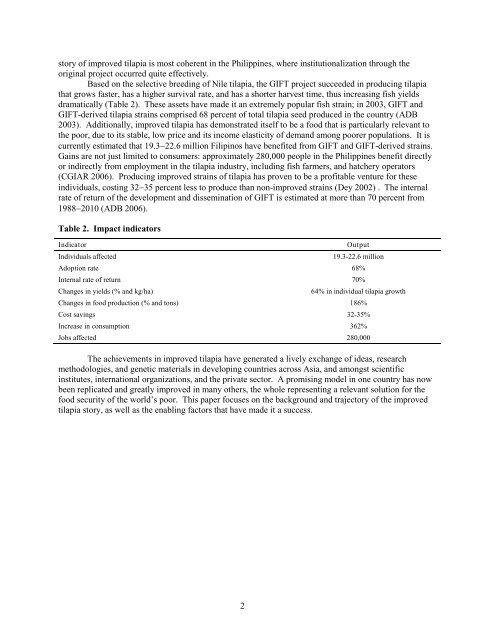Rich Food for Poor People - International Food Policy Research ...
Rich Food for Poor People - International Food Policy Research ...
Rich Food for Poor People - International Food Policy Research ...
You also want an ePaper? Increase the reach of your titles
YUMPU automatically turns print PDFs into web optimized ePapers that Google loves.
story of improved tilapia is most coherent in the Philippines, where institutionalization through the<br />
original project occurred quite effectively.<br />
Based on the selective breeding of Nile tilapia, the GIFT project succeeded in producing tilapia<br />
that grows faster, has a higher survival rate, and has a shorter harvest time, thus increasing fish yields<br />
dramatically (Table 2). These assets have made it an extremely popular fish strain; in 2003, GIFT and<br />
GIFT-derived tilapia strains comprised 68 percent of total tilapia seed produced in the country (ADB<br />
2003). Additionally, improved tilapia has demonstrated itself to be a food that is particularly relevant to<br />
the poor, due to its stable, low price and its income elasticity of demand among poorer populations. It is<br />
currently estimated that 19.3−22.6 million Filipinos have benefited from GIFT and GIFT-derived strains.<br />
Gains are not just limited to consumers: approximately 280,000 people in the Philippines benefit directly<br />
or indirectly from employment in the tilapia industry, including fish farmers, and hatchery operators<br />
(CGIAR 2006). Producing improved strains of tilapia has proven to be a profitable venture <strong>for</strong> these<br />
individuals, costing 32−35 percent less to produce than non-improved strains (Dey 2002) . The internal<br />
rate of return of the development and dissemination of GIFT is estimated at more than 70 percent from<br />
1988−2010 (ADB 2006).<br />
Table 2. Impact indicators<br />
Indicator Output<br />
Individuals affected 19.3-22.6 million<br />
Adoption rate 68%<br />
Internal rate of return 70%<br />
Changes in yields (% and kg/ha) 64% in individual tilapia growth<br />
Changes in food production (% and tons) 186%<br />
Cost savings 32-35%<br />
Increase in consumption 362%<br />
Jobs affected 280,000<br />
The achievements in improved tilapia have generated a lively exchange of ideas, research<br />
methodologies, and genetic materials in developing countries across Asia, and amongst scientific<br />
institutes, international organizations, and the private sector. A promising model in one country has now<br />
been replicated and greatly improved in many others, the whole representing a relevant solution <strong>for</strong> the<br />
food security of the world’s poor. This paper focuses on the background and trajectory of the improved<br />
tilapia story, as well as the enabling factors that have made it a success.<br />
2

















